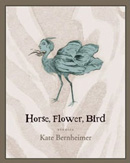

Coffee House Press, paperback, 9781566892476
If you think that Twilight was the best book since The Da Vinci Code, then Horse, Flower, Bird is probably not the book for you. But if you're the sort of person who enjoys listening to curious music on late night FM radio, prefers films that were not made in Hollywood to those that were, and likes to drive different routes home just because, well then, Kate Bernheimer's Horse, Flower, Bird might be right up your proverbial alley. This collection of eight very short stories is most definitely not for everyone. I'm sure many readers will share my first "what the . . . ?!" reaction. Unfortunately, many readers won't get past it. What a pity. Even though I majored in English literature, I won't pretend that I understand everything that Bernheimer writes here. However, I wasn't about to let that get in the way of my enjoyment of these bracingly bleak yet enticingly humorous tales. On first reading, I just let the art wash over me. Originally I set out to read one story at a time, but they were so oddly compelling that I couldn't stop myself from "just one more."
While I was experiencing this book—and the combination of text, illustrations and layout is truly a reading experience— I had glimmers of recognition. The serious humour mixed with the fairy tale elements felt oddly familiar. Then it struck me that it was a little like Edward Gorey: devastatingly sad, but often deviously funny; bittersweet and dark. But yet . . . not. The disquieting pen and ink drawings by Rikki Ducornet added a hint of Karen Elizabeth Gordon (The Deluxe Transitive Vampire), or maybe Nick Bantock (The Griffin & Sabine Trilogy). Favourable comparisons, but ultimately this quirky book owns its unique spot on any bookshelf.
There are several themes that are shared between the stories, and there are motifs and symbols that recur throughout. Most of the main characters are unnamed and referred to simply as 'the girl.' Several of them have rather mean older sisters. Many of them play games of self-denial and isolation. In "A Cuckoo Tale," the little girl 'especially liked The Day of Atonement,' and her favourite game was playing Confession with her Catholic friend, their dolls and the shower curtain. In "A Doll's Tale," Astrid and her sister love to play "Little Matchbox Girl" and fake-starve themselves, and Astrid enters into a dysfunctional relationship with both a life-sized doll and her imaginary friend. Then there's the girl in "A Garabaldi Tale," who dresses in sack cloth when she can get away with it. In the funniest story, "A Star Wars Tale," two sisters act out the movie, with the Princess Leia sister fake-locked in the fake soundproof kitchen closet, where she is under threat of "beating, rape, and other forms of torture" from the Darth Vader sister.
This book continually raises questions. For starters, what is the significance of the title? The "Tulip's Tale" is told
in the first person by a bulb, 'a bulbette really,' so there's the flower, I guess. "A Cageling Tale," about a girl
who builds herself a life-sized cage, is definitely bird-themed. And a miniature horse plays a minor role in "The
Petting Zoo Tale," which is the story of a woman who hides animals in her basement without her work-weary husband's
knowledge. Then there is the two-page opening quotation from Rumer Godden's The Doll House. What is the
significance of that? And I can't figure out what exactly was behind the silencing of each girl that was often
self-induced. The main character in one of the stories says "my voice was a seldom thing," but that phrase could
have been uttered by any one of them. I would love to sit down with Kate Bernheimer over a pot of tea or bottle
of wine and discuss these stories and perhaps get some answers to my numerous questions. But short of that, I look
forward to puzzling out some solutions in my future re-readings of Horse, Flower, Bird. The author is
very brave to send this out to a world where most readers won't get it, but I admire her courage. She won over this
reader, and if you like stories that combine misery with whimsy, are constructed with spare prose and disturbing
undertones, and are often very, very funny, then you may want to take a chance with Kate Bernheimer's latest.
